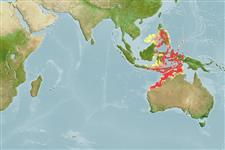Actinopterygii (ray-finned fishes) >
Perciformes (Perch-likes) >
Nemipteridae (Threadfin breams, Whiptail breams)
Etymology: Parascolopsis: Greek, para in the side of + Greek, skolos = stake + Greek, ops = appearance (Ref. 45335).
Environment / Climate / Range
Ecology
Marine; demersal; non-migratory; depth range 40 - 250 m (Ref. 58018). Tropical, preferred ?; 15°N - 23°S, 111°E - 135°E (Ref. 3810)
Western Pacific: including the Philippines, eastern Indonesia and northwestern Australia.
Size / Weight / Age
Maturity: Lm ? range ? - ? cm
Max length : 21.0 cm SL male/unsexed; (Ref. 3810); common length : 15.0 cm SL male/unsexed; (Ref. 3810)
Anal
spines: 3;
Anal
soft rays: 7. Body color is pinkish, darker on the back, grading to silvery ventrally. Four dark brownish-pink saddles are on the back, and a pale lemon-yellow stripe is on either side of ventral midline running from the base of the pelvic fins to the base of the caudal fin. The area between the eyes is greenish yellow. A pale mauve stripe joins the eyes through the nostrils.
Occurs offshore. Feeds mainly on benthic invertebrates.
Life cycle and mating behavior
Maturity | Reproduction | Spawning | Eggs | Fecundity | Larvae
Russell, B.C., 1986. Two new species of Parascolopsis (Piseces: Nemipteridae) from North-western Australia, Indonesia and the Philippines. Beagle, Occas. Pap. North. Territ. Mus. Arts Sci. 3(1):137-142. (Ref. 9923)
IUCN Red List Status (Ref. 115185)
CITES (Ref. 94142)
Not Evaluated
Threat to humans
Harmless
Human uses
Fisheries: subsistence fisheries
More information
Common namesSynonymsMetabolismPredatorsEcotoxicologyReproductionMaturitySpawningFecundityEggsEgg development
ReferencesAquacultureAquaculture profileStrainsGeneticsAllele frequenciesHeritabilityDiseasesProcessingMass conversion
Tools
Special reports
Download XML
Internet sources
